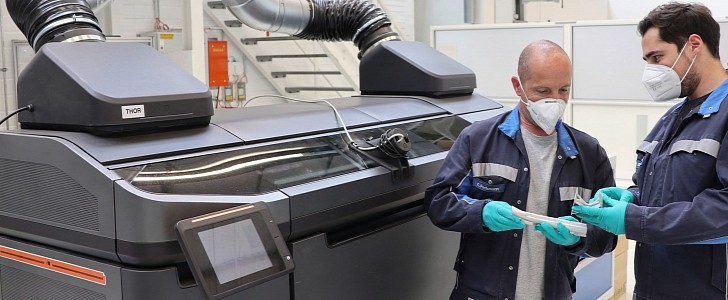A 25-year veteran when it comes to using 3D printing, Volkswagen is now taking things to the next level by introducing a completely new 3D printing process for its car manufacturing, which will result in a higher number of components that are produced this way, within the next 3 years.
3D printing may be old news, but not when it comes to this innovative process that Volkswagen just started implementing at its main plant in Wolfsburg, Germany. Called “binder jetting”, this method boosts productivity and cuts costs, compared to conventional 3D printing, and VW is now the only car maker to use it in the production process.
Instead of building each layer of the component, like conventional 3D-printing, binder jetting uses an adhesive, after which the component is heated and shaped. This makes is lighter and more cost-effective. Another innovative technique was repositioning the components in the build chamber, so that twice as many parts can be obtained in only one printing session.
Three major industry players have worked together to reach this point. Siemens has developed the new additive manufacturing software, HP delivered the high-tech printers, and VW is using the new technology at its main plant. The 3 partners are also planning to create a joint expert team at the Wolfsburg high-tech 3D printing center, starting this summer.
The goal is an ambitious one – to produce 100,000 3D-printed components per year, by 2025. But the first important step has already been successful. The first components made with the help of binder jetting are ready for certification, and these are the components for the A pillar (the vertical support structure on each side of the windshield) of the new T-roc convertible.
It turns out that these parts are 50% lighter than the standard ones, making this technology a game-changer in car manufacturing. And, thanks to this new method, future production-line use is now possible, due to reduced costs.
Unlike before, VW can use this innovative 3D-printing process to make larger volumes of components, faster and at a lower cost.
Instead of building each layer of the component, like conventional 3D-printing, binder jetting uses an adhesive, after which the component is heated and shaped. This makes is lighter and more cost-effective. Another innovative technique was repositioning the components in the build chamber, so that twice as many parts can be obtained in only one printing session.
Three major industry players have worked together to reach this point. Siemens has developed the new additive manufacturing software, HP delivered the high-tech printers, and VW is using the new technology at its main plant. The 3 partners are also planning to create a joint expert team at the Wolfsburg high-tech 3D printing center, starting this summer.
The goal is an ambitious one – to produce 100,000 3D-printed components per year, by 2025. But the first important step has already been successful. The first components made with the help of binder jetting are ready for certification, and these are the components for the A pillar (the vertical support structure on each side of the windshield) of the new T-roc convertible.
It turns out that these parts are 50% lighter than the standard ones, making this technology a game-changer in car manufacturing. And, thanks to this new method, future production-line use is now possible, due to reduced costs.
Unlike before, VW can use this innovative 3D-printing process to make larger volumes of components, faster and at a lower cost.






